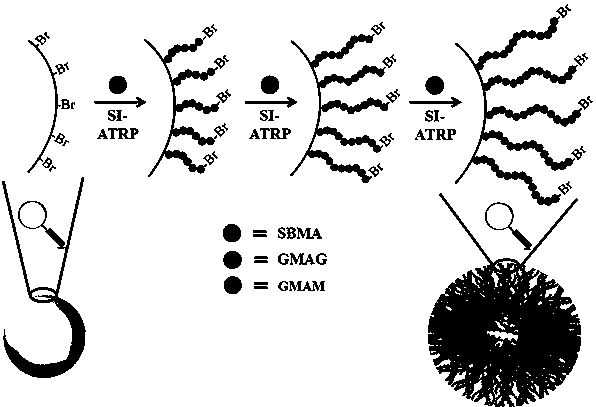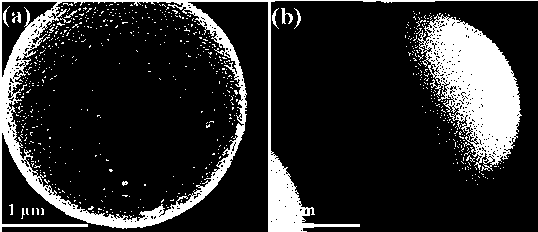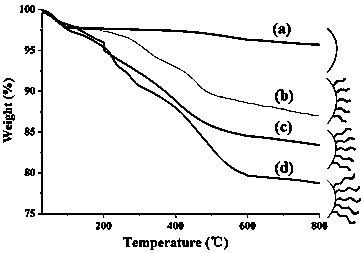Preparation and application of multi-component block hydrophilic copolymer-silica gel hybrid chromatography packing
A block copolymer and silica gel hybrid technology, applied in the field of material chemistry, can solve the problems of low affinity between lectin and sugar chain, low enrichment efficiency, general selectivity, etc., achieve obvious selective enrichment effect and improve identification Effects of Quantity, Increased Efficiency and Selectivity
- Summary
- Abstract
- Description
- Claims
- Application Information
AI Technical Summary
Problems solved by technology
Method used
Image
Examples
Embodiment 1
[0039] Such as figure 1 As shown, the process for preparing multi-component block hydrophilic copolymer-silica gel hybrid packing:
[0040] 1) Synthesis of 2-3-glucosaminopropyl methacrylate (GMAG) or 3-mannosylaminopropyl methacrylate (GMAM) monomer: Into 674.53 μl glycidyl methacrylate (GMA) Add 0.2M sulfuric acid, place it in a water bath at 50°C and heat it for oxidation reaction for 4 hours, and then obtain the oxidized GMA that converts epoxy groups into aldehyde groups;
[0041] Measure another 20 ml of methanol, gradually add 1.1 g of glucosamine or mannose, and stir until dissolved. Add the obtained oxidized GMA dropwise to the continuously stirring methanol solution of glucosamine or mannose amino, stir at room temperature to carry out Schiff base reaction for 4 hours to obtain a yellow transparent solution, and blow dry the prepared solution with nitrogen until it becomes a paste , to obtain GMAG or GMAM monomer, sealed and filled with nitrogen, then stored at 4°C...
Embodiment 2
[0053] Utilize the chromatographic filler obtained in Example 1 to carry out the enrichment of glycopeptides:
[0054] 1) Dissolve 10 mg of the chromatographic filler prepared in Example 1 with acetonitrile, fill it into a 200 µl pipette tip, and precipitate naturally to prepare a solid phase extraction column;
[0055] 2) Weigh an appropriate amount of asialo-bovine fetuin / bovine serum albumin and dissolve it in 50 mM ammonium bicarbonate solution to a final concentration of 1 μg / μl. Add mercaptoethanol at a final concentration of 10 mM, reduce in a water bath at 56°C for 1 hour, then add IAA and place in the dark for 1 hour to denature the protein. Take the denatured protein and add trypsin at a mass ratio of 1:50 (trypsin:protein), place it in a 37°C water bath and incubate for 12 hours, then add 0.1% TFA to inactivate the trypsin to obtain an enzymatic hydrolysis product.
[0056]The asialo bovine fetuin and bovine serum albumin peptide products obtained after the enzymol...
Embodiment 3
[0062] The enrichment of glycopeptides in mouse liver whole protein was carried out by using the multi-component copolymer-silica gel hybrid chromatographic filler obtained in Example 1:
[0063] 1) Dissolve 10 mg of the chromatographic filler prepared in Example 1 with acetonitrile, fill it into a 200 μl pipette tip, and precipitate naturally to prepare a solid phase extraction column;
[0064] 2) Take 50 μg of mouse liver whole protein and dissolve it in 50mM ammonium bicarbonate solution with a final concentration of 2 μg / μl. After thermal denaturation in a boiling water bath for 10 minutes, cool to room temperature, add an appropriate amount of denatured protein to PNGase F enzyme (the mass ratio of enzyme and protein is 1:10), and incubate in a 37°C water bath for 16 hours. The enzymatic hydrolyzate was lyophilized and dissolved in acetonitrile / water / formic acid (80:20:0.1, v / v) with a final concentration of 2 μg / μl. The enrichment process is as follows:
[0065] (1) Ma...
PUM
 Login to View More
Login to View More Abstract
Description
Claims
Application Information
 Login to View More
Login to View More - R&D
- Intellectual Property
- Life Sciences
- Materials
- Tech Scout
- Unparalleled Data Quality
- Higher Quality Content
- 60% Fewer Hallucinations
Browse by: Latest US Patents, China's latest patents, Technical Efficacy Thesaurus, Application Domain, Technology Topic, Popular Technical Reports.
© 2025 PatSnap. All rights reserved.Legal|Privacy policy|Modern Slavery Act Transparency Statement|Sitemap|About US| Contact US: help@patsnap.com



